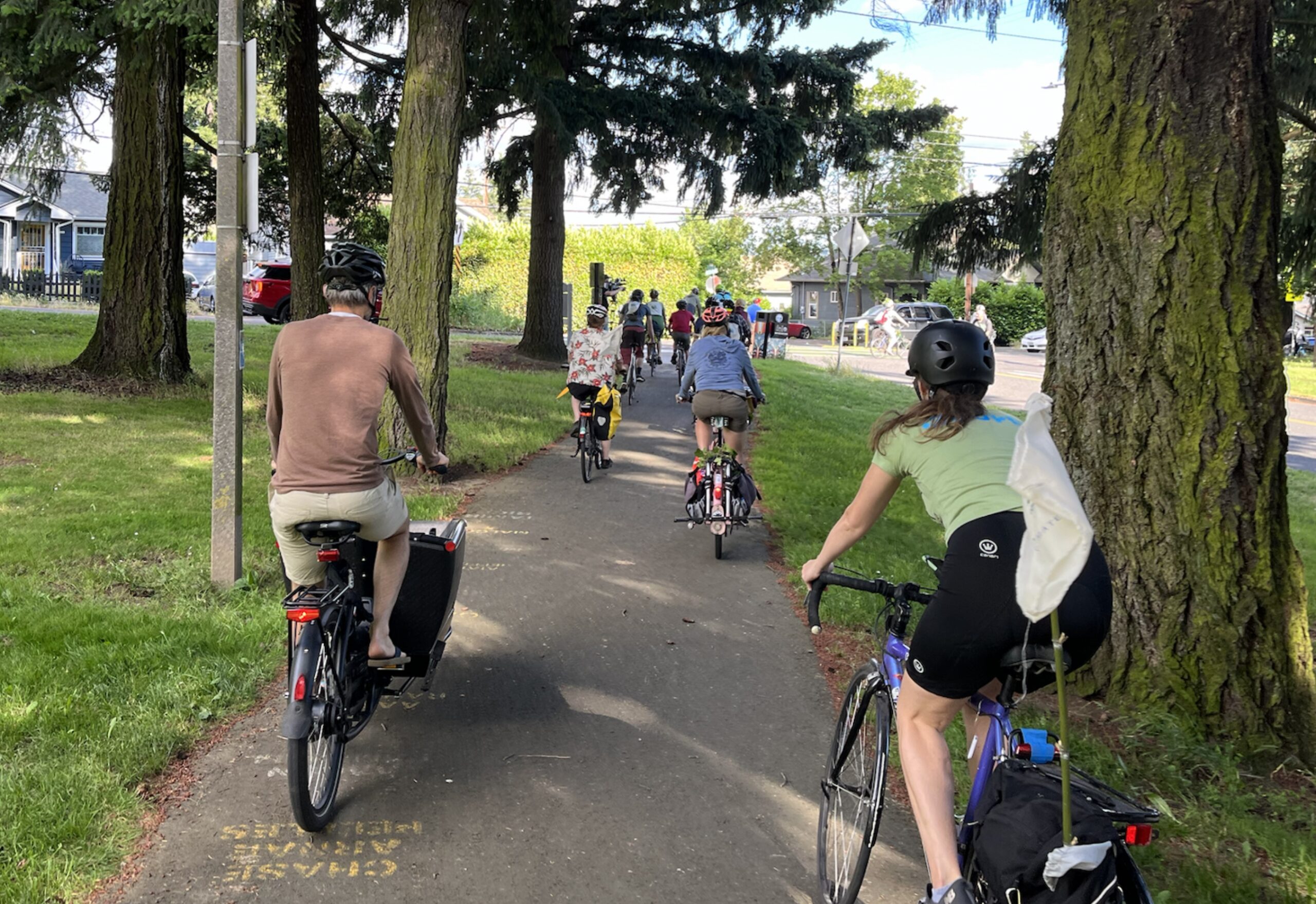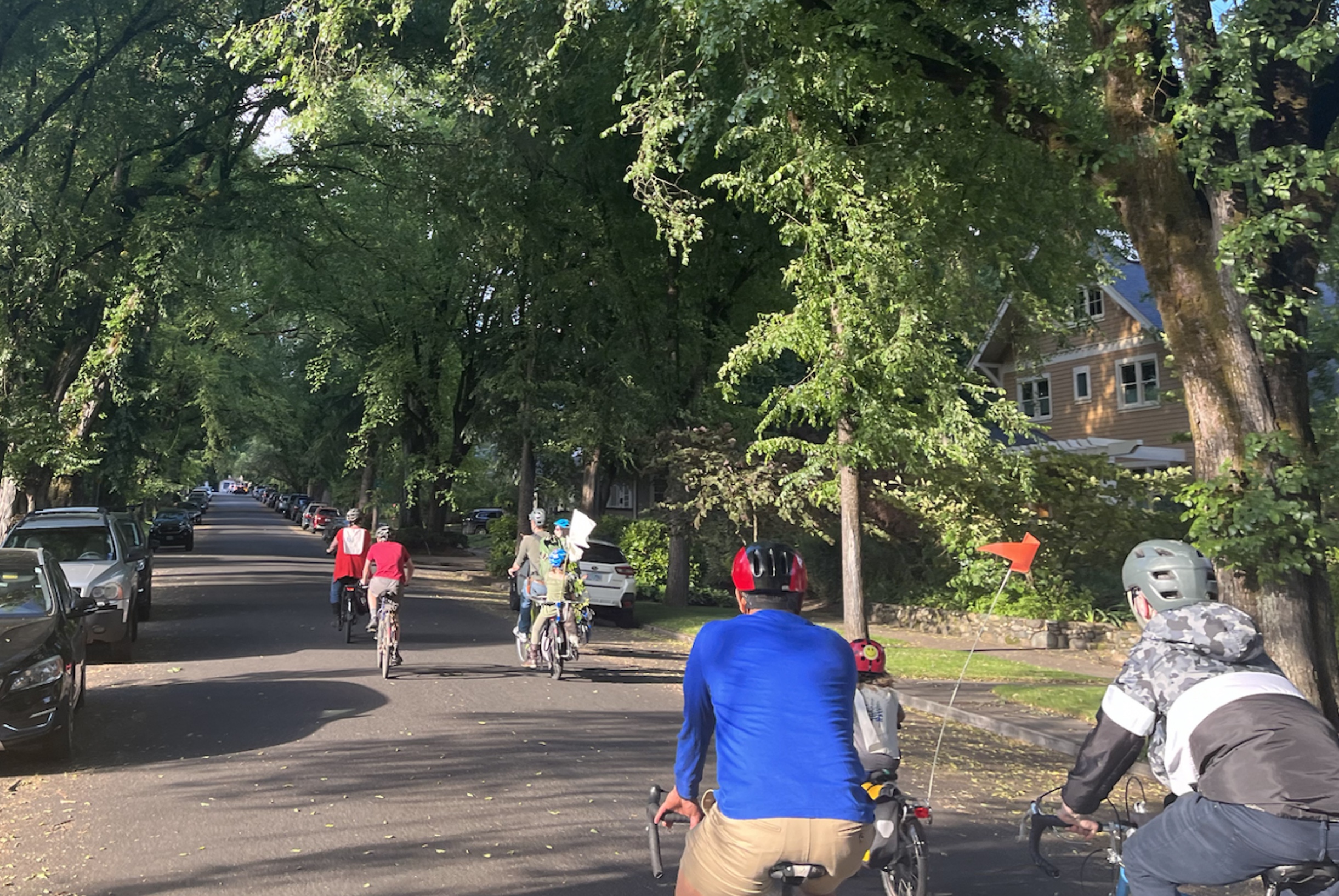The heat dome that enveloped the Pacific Northwest last June was catastrophic and traumatic for people across the region. Temperatures skyrocketed to unprecedented heights: on June 28, 2021, Portland heat reached an average of 116 degrees. This surpassed not only local records, but also shot past the historic high in Dallas, Texas. At the time, it was all anyone could talk about.
But a year has passed, and people tend to forget. In order to make sure that didn’t happen, Portland activists and scientists organized Heat Week to commemorate the anniversary. Throughout this week, they’ve hosted events to remind people what it was like to experience such a remarkable event and recognize the people who were most impacted by the heat, including the people who died because of it.
Last night, I attended one of these events: the Heat Week Climate Resiliency Ride. Activists from environmental justice group 350PDX wanted participants to learn about “shade equity” and how tree canopy coverage — or lack thereof — impacts people in different parts of the city. They led a group of about two dozen people from the lower-income Lents neighborhood near the edge of southeast Portland to Colonel Summers Park in the wealthier, whiter Buckman neighborhood in inner southeast, and the difference in greenery was stark to see.
“One of the things we’re going to be doing in the ride is visually and sensorially taking in the shade,” Brenna Bell, one of the ride organizers and 350PDX’s Forest Climate Manager, said to the group at the beginning of the journey. “We want to help people not just hear about [tree canopy coverage], but also see it and feel it.”
“Feeling it” wasn’t as easy yesterday, because the weather was lovely in and out of shade. Organizers (somewhat) jokingly expressed disappointment about how nice it was – a breezy 75 degrees with some clouds. Fortunately it was nearly 100 just one day before, so it was easy to use our imaginations.
After we left the nicely forested Lents Park and headed on the route, we didn’t see much shade for quite some time. We made our first stop in a parking lot on the corner of Southeast Woodstock and 92nd. Portland State University professor Dr. Vivek Shandas, who researches climate change adaptation and urban heat islands, came out to measure the temperature in this parking lot last year. He found that thanks to an unbalanced ratio of pavement to trees, this spot was the hottest place in Portland during the heat dome, with temperatures reaching an astonishing 124 degrees.
We gathered in this parking lot to have a moment of silence for the 69 people in Multnomah County perished from the heat last year.
“If we don’t bring attention to the fact that so many people died last year, it’s going to be a forgotten topic. And it’s going to be something we just don’t really make much progress on,” Shandas said.
Shandas passed out thermometers so people could see the temperature difference under varying levels of shade and get a taste of the data collection process.
“You can think about what it means to be doing science in a moment of massive transformation on a planetary level,” Shandas said. “This is a way of taking those big global climate models and bringing them down to our backyards.”
One of the most dangerous parts of the heat dome last year was that the temperatures just wouldn’t let up. Usually night time offers a respite, but in Portland’s urban heat deserts, temperatures remained high all evening. In Lents, it remained 91 degrees at night. In places with more shade, evening temperatures dropped to the 60s and 70s.
At the planet warms, urban forestry is becoming a key intersectional issue with transportation infrastructure. Community feedback for the Portland Bureau of Transportation’s 122nd Avenue Plan indicated a strong demand for trees in new streetscape projects – and as more extreme heat events happen due to the climate crisis, the need for trees will become even more evident. Many concerned Portlanders have noticed that TriMet’s soon-to-open Division Transit Project came with large center median islands that are completely devoid of trees.




As we made our way northwest, crossing 82nd Avenue and moving through the Foster-Powell, South Tabor, Richmond, Hosford-Abernethy and Buckman neighborhoods, we saw less concrete and more trees. I could sense the group relax as we headed west onto more tree-lined and bike-friendly streets.
Bringing the benefits of trees to more streets will be essential to reach many of Portland’s planning goals, but some advocates say the City of Portland is falling short on this front. Earlier this year, Portland ended its relationship with non-profit tree-planting group Friends of Trees. The city says it will continue planting trees on its own, but they’ll have their work cut out for them as the canopy is already shrinking due to inclement weather, tree diseases caused by pests, and urban deforestation.
It shouldn’t be difficult to plant more trees. It’s relatively uncontroversial that they’re nice to have around. Trees are a big part of Oregon pride – the big evergreens and Oregon maples are what makes our landscape here so unique and enticing. It’s a luxury more people should benefit from.
“You walk around Portland and it’s literally like being in the forest. It’s is such an amazing place to live, but we have to build it out, and we have to build it together,” Bell said. “Shade equity is part of building a city that works for everyone, and everyone deserves shade.”






